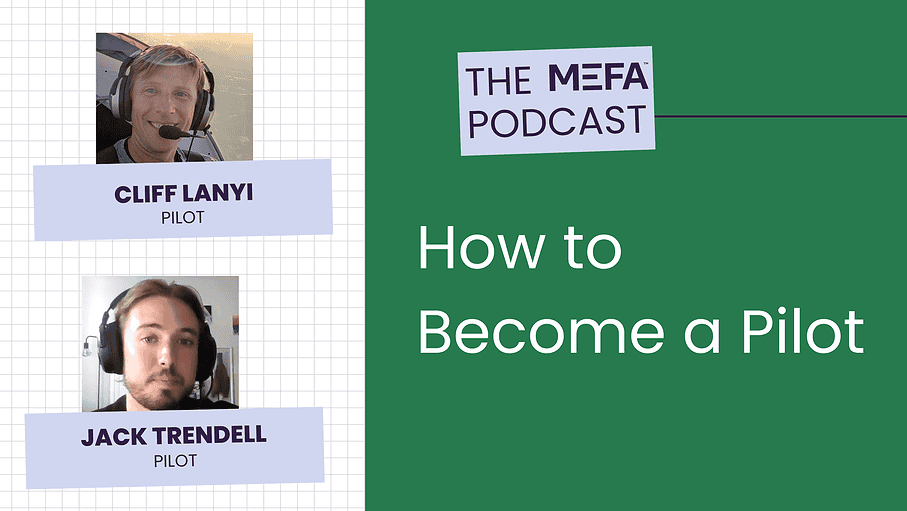Resources Mentioned in this Episode
Cliff Lanyi: [00:00:00] So that’s typically what I do. I go down to New York three times a month, I fly for four days, and I come home on the fourth day, and then I’m off for about four days. And I can make my schedule whatever I want. So next month, if my wife says, we want to try to take this trip on these for this week.
And, oh, by the way, your mom’s coming to visit this week. And, oh, by the way, we’re going to see a concert on this day. You need to get all these days off. Then I make my schedule so I don’t work any of those days. And I work the other days. I don’t take any work home with me either. Because when I’m off, I’m completely off.
I’m not doing payroll or checking emails or anything like that. I just, when I go back to work, I check the weather and I go fly the jets. That’s all I do.
Jonathan Hughes: Hello, everyone, and welcome to the MEFA [00:01:00] podcast. My name is Jonathan Hughes, and you just heard from one of our guests on the show today, pilot Cliff Lanyi. And this is another episode where we highlight a specific career and show you how you can achieve it. And this is something that we’ve done once or twice before on the show, but something we’re going to be doing more of because we’re not just about college at MIPHA, but as we say, college and career readiness.
So I’m going to talk after the interview about how you can use MEFA Pathway, MEFA’s free college and career portal, to explore careers. So stick around for that. But for now, let’s hear straight from the pilots themselves. They’re going to tell us how you become a pilot, what are some of the jobs you can do as a pilot, what makes a good pilot, and so much more.
So without further ado, let’s meet our pilots.
Cliff Lanyi: Okay my name is Cliff. I’m a captain on the Boeing 737 at American Airlines. And I also continue to teach flying lessons. Sometimes on my days off. [00:02:00]
Jack Trendell: My name is Jack Trendell. I’m a pilot for the Boston Skydive Company and a remote pilot operator for the Federal Aviation Administration, a contractor.
Jonathan Hughes: How long have you been a pilot?
Cliff Lanyi: I got my pilot’s license in 2005 and I’ve been at the airlines for 11 years.
Jack Trendell: So I started flying in August of 2019. That’s when I started my training at Bridgewater State University.
Jonathan Hughes: And what was it like taking those classes at Bridgewater?
Jack Trendell: I had never felt so driven to do well in the classes. They were about things that I was extremely interested in. So it’s a four year program, and ideally every year you’re supposed to get About one license. So you go through and your flying is a class in and of itself. So you have to take all of these other courses like you would at a normal university.
And then you get onto the airport. They use New Bedford Regional Airport. It’s where they have their flight training center. Yep. [00:03:00] And By the end of the program, ideally you have your commercial pilot’s license as well as your certified flight instructor license.
Jonathan Hughes: What was your schooling like? What was your educational journey to becoming a pilot?
Cliff Lanyi: Mine was pretty piecemeal. It started out as a hobby for me. I went to college at Penn State. I got a bachelor’s in meteorology. And then I got my private pilot’s license at a small flight school outside Washington, D. C. while I was down there one summer for an internship.
So I just took flying lessons, started in June, licensed by September. That was the private pilot’s license. I got my other ratings at different flight schools around the country, because after college, I commissioned in the Air Force. I was a weather guy, so I traveled around the country, and everywhere I’d go, I’d find a local flight school and get my instrument rating, and then my commercial, and then my flight instructor rating, all at different schools.
Jonathan Hughes: So take me through that a little bit. So you started at Penn State and you studied [00:04:00] meteorology there. Yep. And that is what your degree is in? Yes. And where does the Air Force come in then?
Cliff Lanyi: I did ROTC at Penn State, so as soon as you graduate, you go off, you have a job. And that’s what I did weather forecasting for the Air Force.
Jonathan Hughes: Okay, did you fly in the Air Force or just do the meteorology?
Cliff Lanyi: Just meteorology. Flying was a hobby for me. So I had my license by the time I graduated college. I got it that summer. Walked into the office there. It was called Freeway Airport. Tiny little airport, weeds growing out of the runway.
But you could see the White House right after you took off. So you’re really in close. And I just said I’d like to take flying lessons. And The girl at the desk said they were too busy for the next couple weeks and I said that’s fine, whenever you have availability. She said two weeks from now we got a plane, we’re going to put you with Paul.
I said okay, I don’t know who Paul is, that sounds fine. So I showed up on the appointed date and Paul wasn’t particularly nice, the plane was beat up, but I loved it. [00:05:00] I was hooked. I signed up for all the lessons I could get after that. By the end of the summer I had my private pilot’s license.
Jack Trendell: It took me about 45 hours of flying time. About three months.
Jonathan Hughes: That’s the private pilot’s license. That’s the first one that you got.
Jack Trendell: The private pilot license is the first and all that means is you can go flying, but you cannot make any money doing it. And then from there you get what’s called an instrument rating. The next one was my instrument rating.
Cliff Lanyi: That one allows you to fly when the weather is Too poor to see outside the window. And so what was that like? It was you wore fogles the whole time, basically in, in the training. So you put these glasses on and they block everything outside the windscreen and all you can see is the instrument panel. And then you go fly around without looking outside.
Jack Trendell: That’s how all of the, people in the airlines fly you something you need, if you want to fly, as most people think of a commercial pilot.
Cliff Lanyi: The third one I got at in Hawaii. That was the commercial license.
Jack Trendell: And then [00:06:00] after that, you go and you get your commercial certificate.
Cliff Lanyi: Commercial license allows you to fly for hire now. So you can make money flying people.
Jack Trendell: Exactly, you can make money now.
Cliff Lanyi: My first flying job was towing gliders. So at the, it was in Hawaii after I got my commercial license. They would take tourists up in the gliders, and they had all sorts of tour packages, and they needed an airplane to tow them up.
You basically just attach a rope from the back of the airplane to the front of the glider, you tow them up, and when they get to a certain altitude, You release them? I got $10 per tow for the first 10 tows, and after that I got $1 per tow.
Jonathan Hughes: Seems like a lot of work for a little money.
Cliff Lanyi: It is this was the draw. I didn’t do it for the money. It was building flight time, which really wasn’t my goal. My goal was to be able to fly for a purpose. And have fun doing it.
Jonathan Hughes: So the commercial pilot license is one that you earn at Bridgewater. Is that the [00:07:00] last license you earn there?
Jack Trendell: No. So the last thing you do is the certified flight instructor rating. So that is its own license. You have you can only get once you’re a commercial pilot. And once you’re done with that, you have your commercial license and a flight instructor license. When you leave the program, ideally you can get a job. at a local flight school. You can even work for the university as a flight instructor.
And it’s a great way to help build your flight time because if people people want to take the professional pilot track, when I say professional, I mean going to fly an Airbus or a Boeing airplane, something like that. You need to have you need to get to generally it’s 1500 hours of flight time.
Through a college program that can be reduced. So with Bridgewater, it’s 1, 250 hours. But it’s a great means of being able to get those hours. You get a lot of good experience as a flight instructor.
Jonathan Hughes: You’re pretty fresh out of the program though, right?
Jack Trendell: I finished the program up in about a year or two ago. [00:08:00] So out of the program I actually did this job that I’m doing now. I’m flying skydivers and I also worked as a banner tow pilot. So if you ever go to the beach and you see the planes towing the, the advertisements, that’s what I was doing. And then after that I worked for a I got hired to fly seaplanes.
So I actually went and got my seaplane, my commercial seaplane license as well. And I worked for an airline that flies seaplanes between Boston Harbor and the East River in New York City.
Jonathan Hughes: Okay, so give me a sense of how much more difficult each step is from the last, like how, and what is it like to make that next level in terms of like applications and paying and, for the courses and things like that. What was that?
Cliff Lanyi: It’s much more expensive today than it was when I did it. But I paid 40 an hour for a Cessna 152 when I got my private pilot’s license. And so that’s, is just the time the engine’s [00:09:00] running. So the whole thing probably cost. It probably cost me 000 to get the private pilot’s license.
Nowadays it costs more, probably twice as much. And then same for the instrument rating. Same for the commercial. It doesn’t really get more expensive. The price is pretty much the same all the way through. If you go to an aviation college, I know that they’re expensive. But they, there are loans that you can get.
There are scholarships that you can get. And there is the American Airlines Cadet Program. If you get accepted there, they give you either an interest free or low interest loan. I’m not exactly sure, but then they also give you a job as soon as you get your instructor license, which is the next one after commercial in this train of licenses.
You have a job teaching students and you’re getting paid for it and you’re accruing flight time towards becoming the airline transport pilot. And as you need 1, 500 hours to become an [00:10:00] airline transport pilot or ATP. So when you hit your 1, 500 hours. You get that while teaching, the airline brings you in.
Jonathan Hughes: Are there other types of things that you can do as a pilot and make money without being a big sort of commercial jet pilot?
Jack Trendell: Yeah, definitely. There’s Things such as as I said, flight instructing. There are some people who make a career out of that. Flying skydivers towing banners working for working in the charter world, or the corporate flying world, so you’re flying a private jet.
Cliff Lanyi: Pipeline-
Jack Trendell: Patrol, aerial-
Cliff Lanyi: Photography-
Jack Trendell: Charter flights, cargo. Aerial firefighting. Go out to California Arizona, out west, there’s every summer there’s a lot of fires. You could fly for the government. Being flying for Customs and Border Patrol, or there’s a lot of things.
Jonathan Hughes: What do you think you will do from here? Are you going to keep on doing what you’re doing for a while, or do you have plans to do other things?
Jack Trendell: Yeah essentially these jobs that I’ve worked in the last few years have all really been to help build my [00:11:00] experience, so that I can I can apply to an airline. Once the season is over for the the skydive Flying a lot of the stuff is seasonal up here.
I’ll be hoping to be to be interviewing with some airlines and ultimately I think that’s probably, for me anyway, the smartest decision.
Jonathan Hughes: Now, when did you have it in your mind throughout all this that you were going to be a pilot, that this was what you were going to do for, be a commercial pilot?
Cliff Lanyi: When I started getting emails from the airlines, because I had accrued enough flight time and they were looking for pilots and Yeah, like they’re spam emails. I would have thrown them in this junk folder, but I’m looking at this you know come fly for American Eagle Airlines. We’ll here’s your starting salary We’ll train you up and this and that and say whoa, here’s the link to apply Okay, so I did that they hired me.
I got hired at three different airlines and I actually asked my wife if she thought I could go fly a big jet, and she actually laughed at me. It was more like a, I’ll show you, I’ll do this. I went [00:12:00] to training, and it was really neat. To the first time I flew the jet was really exciting, but to be a airline pilot is a different part under the regulations.
Part 121 is scheduled air carrier service. So in order to fly for them, you need your next rating, which is an airline transport pilot license. They train me, so you get hired, you get paid to go and get trained. You go down to ground school for the basic indoctrination, which goes for a week or two.
After that, there was about four weeks of systems ground school for the jet that you’re going to fly. It was three weeks. And you have to pass an oral exam on that, a written test and an oral exam. And when that’s done, you go to the simulator. And there’s two weeks of simulator training in the in the simulator full motion simulator with a fully reproduced cockpit.
You forget you’re in a simulator. It’s so good. Sometimes you do that for two weeks, you have to take a [00:13:00] flight test. It’s really a simulator test. And after that, the next part of your training is to go out and fly passengers. The first time you fly the jet, it’s full of passengers and you are with a Czech airman, an instructor pilot, who is your captain and you are the co pilot.
The passengers have no idea. You are new to flying the jet, although you did just do two weeks straight in the simulator. Simulating every emergency, every scenario that they think could happen to you. So you are very good at flying the simulator at that point. The jet’s a little different. The operational pace might be a little bit different.
But you are a competent pilot by that point. Plus you’re accompanied by a very competent instructor pilot. I almost quit a few times because I didn’t like reserve. So reserve if you’re a junior pilot at the airlines, you’re on call. And because I was based in New York, but I live up here in Massachusetts, it was difficult.
I had to go down to New York because if they called me, I had to be ready. So I didn’t [00:14:00] like that, and they weren’t hiring a lot of new pilots, so I wasn’t moving up in the seniority list, so I was going to be on reserve for a while. So I thought I was going to quit, but then when I started getting a little more senior, I saw how great this job can be, and I’ve been there ever since.
Jonathan Hughes: Wow. Talk about that a little bit more. Okay. About, about being an algorithm. How great it can be.
Cliff Lanyi: Oh, man. All right. You bid your schedule every month. You look at we have something called PBS, Priority Bidding System. You put seven layers. In your top layer, you shoot for the moon. You say, what would be my ideal schedule?
I would want to work only, Monday through Wednesday, I would like to fly nowhere but, Cabo and the islands with 24 hour all inclusive hotels. And I want to not start before 8 a. m. and I want to be home by 4 p. m. on my last day. So you can put that in your layer number 1. The most senior guy will get that.
And then you can say, if you can’t give me that, then layer [00:15:00] 2, layer 3, all the way down to layer 7. So you, it’s complicated how that works, but you get good at it. I’m fairly good at it. I just pick the trips that I want and I put them in layer one. So I say, I would really like that trip, and I would really like that one.
They’re trips that are already built. They could be two day trips, three day trips, four day trips. I prefer four day trips because I go down to New York and so I don’t need to go back and forth as, as often. I can do. three, four day trips a month and just be done. That’s my whole month schedule.
So that’s typically what I do. I go down to New York three times a month. I fly for four days and I come home on the fourth day and then I’m off for about four days and I can make my schedule whatever I want. So next month, if my wife says we want to try it, we’ll take this trip on these for this week.
And, oh, by the way, your mom’s coming to visit this week. And, oh, by the way, we’re going to see a concert on this day. You need to get all these days off. Then I make my schedule so I don’t work any of those days, and I work the other [00:16:00] days. I don’t take any work home with me either, because when I’m off, I’m completely off.
I’m not doing payroll or checking emails or anything like that. I just, when I go back to work, I check the weather and I go fly the jets. That’s all I do. I’m walking into that office. that first day to flying the jet. How long was that? For me, it was 2005 when I got my license and it was 2013 when I got hired at an airline.
So it was eight years, but I was not trying.
Jonathan Hughes: Is the sort of college aviation program A shorter, more direct route to being a pilot.
Jack Trendell: If you want to become a, an airline pilot, I think it’s a great way to go about that because you your training and your education is focused on that type of flying, but at the end of the day.
You could just go to a local flight school, and if you have the means [00:17:00] to, and you have the ability to go fly every day. I know a lot of people who, in, within the span of two, three years are flying at the airlines. Starting from zero to going to flying at the airlines.
Jonathan Hughes: What skills make a good pilot?
Cliff Lanyi: I think the two main ones that come to mind is first the ability to plan So if the airplane gets somewhere before your brain does then trouble starts.
Jack Trendell: I think the biggest one is being able to Work well under pressure.
Cliff Lanyi: The quote goes you have to stay ahead of the airplane Which means your mind has to get somewhere before the airplane does The faster the airplane, the bigger of a challenge that, that is.
Jack Trendell: A lot of the training especially in the airlines is focused on emergencies and being able to know what you’re supposed to do and to be able to make rational decisions, which is easier said than done.
Cliff Lanyi: You can’t just fly the jet into Chicago. [00:18:00] And not plan your whole arrival, your landing, and your taxi into the gate. You have to plan that all out. The second skill is the ability to prioritize. So when you can become task saturated by a whole lot of things bombarding you at once. So you have to be able to pick, what do I need to focus on first?
99 percent of the time, that is flying the airplane. An example of not prioritizing flying the airplane is if you are flying along and air traffic control says, you have traffic, it’s 12 o’clock, he’s 1000 feet below you. And then very often a student pilot will hear that and he’ll go, Where?
Where? Where’s this traffic? He stops flying the airplane. It starts going this way and starts descending. And, you’re at this altitude, he’s a thousand feet below you. If you simply held your altitude, you would miss him, right? But they start a dive looking for the airplane. So they have to remember to fly the airplane first.
Jack Trendell: Communication being able to work well with other people. That’s one thing I had to get used [00:19:00] to. I spent most of my flying career getting taught or flying by myself and then going to fly seaplanes. I was all of a sudden sitting next to a captain that had a lot more experience than I did and had a lot of insight into how I can improve myself.
And that is, that’s how it is at the airlines. You’re always flying with someone else. And, you might spend five, five days up to a week with them. And you have an important job, so you have to make sure you can communicate well with people.
Jonathan Hughes: Yeah, that’s a great point. I never would have thought of that. I mentioned this when we talked before the show, but this whole idea for the show came from my son’s friend who is 11 and he wants to be a pilot. Plays Microsoft flight simulator all the time. And I told him, he asked if I would have a pilot on to talk about what he needs to do to be a pilot.
Cliff Lanyi: First stay in school. I would recommend going to college and studying something technical math, science, engineering, physics, something like [00:20:00] that. It’ll give you just an appreciation for how machines work how physics works, flying is all physics science you materials even all of that will benefit you and get you to understand the bigger picture.
It’ll make flying easy if you have a kind of a technical background. The second thing to think about is to try to get some flying hours and go get a pilot’s license. Even if you do end up going to an aviation school, you’ll be ahead of the game if you get there with a pilot’s license. It’ll be easier for you.
You’ll get through more quickly and it’ll be a lot cheaper. I know it’s not always financially possible for someone to just go out and get a pilot’s license, at least not early in their career. But what I have a, I know a lot of people that in the past they went and they hung out at the airport and they actually did things like they washed the airplanes and they moved the airplanes around the ramp and they refueled the airplanes and instead of getting paid for it, they traded them flight time.
So they got their licenses that [00:21:00] way in exchange for doing work at the airport. At the very least, you should go to the local airport, check out the local flight school, find out what it costs, find out if there’s anything you can do to help them even get some flying time. If you know anybody at the airport who has an airplane, the pilots are always happy to take you up and teach you what they know.
Anything you can do to get ahead of the game in that regard. There was one other thing I was going to, yes. Say, either get a textbook, a private pilot, or a book, a private pilot textbook or just a book about flying, and read it. Or, these days, what do people do? Online classes, right?
Take an online class about getting a pilot’s license. It’s really interesting, they usually have good graphics, and you’ll learn so much from it. And, continue to learn what you can from FlightSim. If you take that online class or read the book about flying, and then you go back to that flight simulator, man, they are so realistic these days.
Everything you read about in your book is going to be fairly faithfully [00:22:00] represented in the flight simulator. And I think the newer flight simulators even have a private pilot class. Now obviously it’s not a real private pilot class, but it’s pretty close. The things that they’re teaching you are true to life.
And so if you go through that, you’re just playing, you’re having fun, but you’re learning so much. Then you go to get your license, you’re going to be way ahead of the game.
Jack Trendell: Things like Microsoft Flight Simulator are great. They’re, they teach you a lot about the systems of an airplane. The cockpit and the controls are all very, the buttons are all going to be the same as when you hop into that same airplane in real life.
It’s a great learning tool. When I was growing up for Christmas one year, my, my parents had gifted me a it’s called a Discovery flight. Around, it’s around it’s a couple hundred dollars. You go up for about an hour you go out with an instructor and they show you how to do all the pre flight checks and show you the checklist and everything and then they put you in the pilot seat and you go up and you just fly around and see how it [00:23:00] is that’s a great way to see if this, sitting in that airplane and flying around is something that yeah.
Your body can handle because some people get air sick and they don’t realize it. I think overall, it just Kind of lights that fire more if someone’s passionate about aviation and you can do it really at any age.
Jonathan Hughes: How old were you when you did it?
Jack Trendell: I think 14 years old.
Jonathan Hughes: How old do you need to be before you start getting your pilot’s license? Is it like a driver’s license?
Cliff Lanyi: Sixteen to solo the airplane, 17 years old to get your pilot’s license. But you can start training at any age. If you’re going to go quickly through it, I think a good time is 15, but yeah, you can solo at 16, license at 17, commercial license at 18, and the airline transport pilot license at 21.
Jonathan Hughes: Any advice for any prospective pilots out there, anyone who’s listening to this and thinking that they might want to do this?
Jack Trendell: You have to figure out if you really love it. [00:24:00] Aviation is, especially as a pilot, you make a lot of sacrifices. You spend a lot of time studying in school, hard work.
You’re going to work a lot of holidays you’re going to work a lot of overnights. And if you, if it’s something that you love all of that, those negative things really don’t seem so negative.
Jonathan Hughes: Thank you so much for being here. I really do appreciate it.
Jack Trendell: Yeah, of course. Thank you so much for having me.
Cliff Lanyi: My pleasure.
Jonathan Hughes: That was awesome. I’d like to thank Cliff and Jack for taking time out of their busy flying schedules to come and talk to us. I really loved it. I hope you did too. And if anyone listening wants to explore this career or any other career through MEFA, I want to make sure you know how you can do that through MEFA Pathway, MEFA’s free college and [00:25:00] career portal.
Here’s how you do it. You go to mefapathway.org, sign in if you have access or sign up if you don’t. And click on the Discover Careers tab. Then click on Career Search. And now let’s again assume that you’re so taken with today’s guest that you want to look into being a pilot. You can scroll through the menu of Career Categories all the way to the bottom and click on the Career Category Transportation.
Distribution and Logistics. And there will spring up all sorts of careers in that field, including airline pilots. So click on that option, and get all sorts of relevant information about that career, like average salary, what percentage of pilots have what degree, and links to colleges that offer programs in aviation.
Finally, I mentioned during the interview that this whole idea for this show came from my 11 year old son’s friend who wants to be a pilot [00:26:00] and asked me to have some pilots on the show so we could learn how to be one. And honestly, I would love to get more ideas just like that from you. So if you have a career dream and want us to help you get there, tell us what that is.
And you can reach us on Facebook at @MEFAMA, on X @MEFATweets, and on Instagram at @MEFA_MA so if you like today’s show, you can follow us wherever you get your podcasts, and please be sure to rate and review us. Finally, I’d like to thank Shaun Connolly, our producer, Meredith Clement, AJ Yee, Lisa Rooney and Lauren Dance for their assistance in getting this show posted.
Once again, my name is Jonathan Hughes and this has been the MEFA Podcast.












